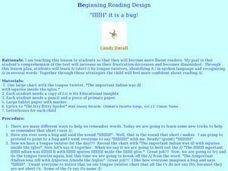Curated OER
Vowel Sounds and Spellings
In this vowel worksheet, students complete multiple choice questions, selecting the word that comes next in a rhyming sequence. Answers and explanations are given.
Curated OER
Iggy and the Icky Sticky Inchworm
Students read and spell words. They have to recognize that letters stand for phonemes and spellings map out spoken words. Long and short vowels are hard to recognize and this lesson focuses on that. The short i is taught in the...
Curated OER
Juggling Bugs
Students examine the letter 'u'. Through instruction and modeling they explore the sound the letter makes, how the letter is written, words that contain the letter, etc. They say tongue twisters with the /u/ sound in them. They listen to...
Curated OER
Ii
In this alphabet awareness activity, students circle each picture that begins with the long or short /Ii/ sound and then make an x on each picture that does not begin with the /Ii/ sound.
Curated OER
Ned's Red Guitars
In this phonics practice activity, learners examine 10 words that have "ea" in them. Students color the guitars with the long e sound red and those with the long a sound gray.
Curated OER
"IIIIH" it is a bug!
Students practice the long and short vowel sounds of /i/ in a variety of text with assessing different strategies. They utilize tongue twisters to assist them including "The Itsy Bitsy Spider" and "Liz is Six." Letterboxes are also...
Curated OER
Alphabet
Students state the letters of the alphabet individually and in new words. For this alphabet lesson plan, students use the alphabet in a variety of ways during reading.
Curated OER
Beginning and Ending Sounds
First graders practice the beginning and ending sounds of words. In this phonological awareness lesson, 1st graders use picture cards for one syllable words and pronounce each word. Students match other picture cards with the same...
Curated OER
Beginning, Middle, or End?
Here's a worksheet to help students become familiar with where to find words in a dictionary. Students whether the each of the 15 flower related words would be found at the beginning, middle or end of the dictionary.
Pennsylvania Department of Education
Writing With Environmental Print
Young scholars develop literacy skills by exploring street signs, cereal boxes, and billboards. In this writing with environmental print lesson, students build word recognition in every day print. Young scholars decode words and discover...
Curated OER
Letter Recognition Flash Games for Kids
Students explore the alphabet by completing an on-line letter identification activity. In this phonetics lesson, students utilize the website www.literarycenter.net and listen to word sounds as they identify the spelling of the...
Alabama Learning Exchange
Phonics lesson for -ick family
Kindergarteners and first graders develop phonemic awareness for words that contain -ick. Each learner gets a stack of cards with different -ick words, highlighting the target sound as they review each one.
Curated OER
ESL Pronunciation Exercise
In this pronunciation worksheet, students underline words with short vowel sounds and categorize words according to stressed syllables.
Curated OER
Sound the Foghorn
Learners complete a variety of activities related to the long /u/ sound. As a class they recite a tongue twister, then trace and write the letter U. Students then listen to pairs of words and identify which word contains the long /u/...
Curated OER
Letter Names
Students explore language arts by participating in a letter identification activity. In this word recognition lesson, students are shown a list of vocabulary terms which they practice reciting with their classmates. Students identify and...
Pennsylvania Department of Education
What's My Sound?
Pupils follow a power point presentation to practice the sounds each letter of the alphabet make. For this 'what's my sound' lesson, students apply word recognition strategies and demonstrate listening and comprehension skills to build...
Curated OER
Here's and Instant Activity for October 20, 2008
Learners complete spelling activities for words with or and ore spellings. In this spelling lesson, students find antonyms for the 'or' words in the first exercise. Learners find synonyms for the second exercise.
Curated OER
Double Jeopardy-Homophones
Second graders identify homophones as words that sound alike but have different meanings. They, given a pair of homophones, are to explain the meanings of the words using gestures, role playing, or drawing a picture with their partner.
Curated OER
First Day of School
Primary learners complete pre reading, writing, during reading, and interdisciplinary activities for the book First Day of School. They will complete journal entries, answer short answer questions, have discussions, and much...
Curated OER
Sorting words (four-block)
Third graders each receive an index card with a word written on it. They look for spelling patterns such as "oi." Students sort the cards according to spelling pattern, and practice spelling words with the snap, clap, slap hand motions.
Curated OER
A? Speak up, I can't hear you!
Students become phonemically aware of various sounds that make up written words. This instructional activity focuses on the vowel correspondence a_e=/A/. They decode the long a mouth moves in words as well as practice spelling the words...
Curated OER
ADULT ESOL LESSON PLAN--Skills Necessary to Listen, Speak, Read and Write Effectively
Students, using a basic word picture dictionary, review the vocabulary terms on the board in conjunction with the picture dictionary and tie the two together for placement association. In addition, they practice using key grammar words...
Curated OER
What Do Seals Eat?
Students recognize the ea=/E/ correspondence in spoken and written words. They participate in a group letterbox lesson plan. In groups of two, they practice reading with each other, taking turns reading one page at a time, identifying...
Curated OER
Comparatives
In this comparatives worksheet, students review and discuss adjectives. They define adjectives as words used to compare two things using superiority, equability and inferiority. They then complete six comparative prompts by creating...

























